|
About 20 years ago
, a cousin of mine who had been collecting family histories and doing
genealogy, turned over to me hundreds of pages, copies of her work, family trees and
genealogy forms and interviews, that she felt I might be able to computerize.
It was five or six years before I worked up the courage to even begin looking
through this formidable pile. Browsing through it all, spotting familiar names and some
unfamiliar ones, I was surprised to find one piece of paper. This had events on it I had
never heard of, history I was completely unfamiliar with and characters whose only
connection was an ancestral last name.
Because part of my family is Irish, I telephoned the elderly aunt who had
written this page in 1943, an interview she had had with a great‐uncle, to ask if
this might be Blarney. No. This was the Scottish side of the family. Not into spinning
tales. Nor was my aunt. Definitely lace‐curtain on the Irish side and she assured
me,
#1: the uncle was never a story‐teller and
#2 she had
written down exactly what he had said:
|
|
Two brothers, conscripted off Isle of Skye, Scotland, on English
man of War to America.
Both brothers helped build privatier (sic) Gen. Armstrong War 1812.
They stayed with the ship until wrecked.
|
|
What could this mean? Privatier? Pirates? Like Jean Lafitte or Burt Lancaster in
The Crimson Pirate? My ancestors?
On the other hand, to me, like so many Americans, The War of 1812 was one of
those minor conflicts, ambiguous in outcome. Not WWII or The Civil War. Perhaps
best described as a war between wars: between The American Revolution and
The Mexican‐American War or certainly The Civil War.
Only when I became involved with NYMAS and weekly heard a parade of lauded
historians, authors of dozens of books, authoritative experts and the probing of
primary sources and the re‐spinning of the past, did I begin to take this
seriously.
I'll confess to having started my research, not on computer, but from
some of the dustiest books in the New York Public Library's Research Branch.
But there it was: General Armstrong parenthesis (ship) published as early as
1833.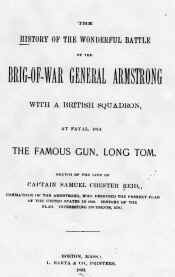
And within the text, I found almost a lifetime of research, at least for an
inventive history buff:
Here are two references I found within those dusty volumes.
The first records ex‐President Teddy Roosevelt talking to the
book's author from the railing of a ship anchoring in the harbor of a port
on an island in the mid‐Atlantic:
_______
"In there," said the ex‐President, pointing
eagerly as our anchors rumbled down, "was waged one of the most desperate
sea‐fights ever fought, and one of the least known; in there lies
the wreck of the
General Armstrong
, the privateer that stood off twenty times her strength in
British men and guns, and
thereby saved Louisiana from invasion."
My second initial find was a letter by a British eyewitness on shore
during the sea‐fight in 1814:
"After burning the privateer, (Captain) Lloyd made a demand of
the governor to deliver up the Americans as his prisoners, which the governor
refused. He threatened to send five hundred men on shore and take them by force.
The Americans immediately retired, with their arms, to an old Gothic convent;
knocked away the adjoining drawbridge, and determined to defend themselves to
the last. (Lloyd), however, thought better than to send his men. He then
demanded
two men
, who, he said, deserted from his vessel when in America."
Ultimately, I consulted a hundred books plus original documents in
the Admiralty and Foreign Office files at the Public Record Office in the UK, the
National Archives and the Manuscript Division of the Library of Congress, and did
online interviews with descendents of both the American captain and the British
captain. (Incidentally, over all, the event with the General Armstrong seems to be
mentioned in perhaps a quarter of the War of 1812 literature.)
|
|
The facts seem to be these:
The ship The General Armstrong
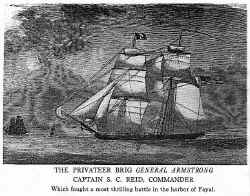 named after the
Secretary of War, was built in 1812 in a very busy shipyard on New York's East River
by the brothers Adam and Noah Brown. The shipyard was at the end of Houston Street and the
money was put up by Renssalear Havens and other New York investors who would, after
clearance by a prize court, share the proceeds from their captures with the captain, crew,
American Marines and other stockholders. named after the
Secretary of War, was built in 1812 in a very busy shipyard on New York's East River
by the brothers Adam and Noah Brown. The shipyard was at the end of Houston Street and the
money was put up by Renssalear Havens and other New York investors who would, after
clearance by a prize court, share the proceeds from their captures with the captain, crew,
American Marines and other stockholders.
Samuel Chester Reid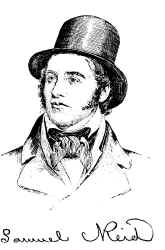
was the second captain of the Armstrong, born in Norwich, Connecticut, in 1783, son of a
British Naval officer. The senior Reid was taken prisoner in a night boat expedition at
New London, Connecticut, and afterward resigned his commission to become an American
citizen. At the age of eleven the son went to sea, was captured by a French privateer and
confined for six months at Basseterre, Guadeloupe.
The actual event:

September 26, 1814. Sundown. In the North Atlantic, in the Azores. about 1/3 of the way
between Portugal and the United States in the neutral Portuguese port of Fayal (Faial).
The American privateer, the GENERAL ARMSTRONG, is taking on water and supplies. Three
British men‐of‐war unexpectedly appear, sailing into the mouth of the
harbor. The British commander, Robert Lloyd, irrationally seems to delay his mission
which was to join the flotilla assembling in the Caribbean for the Battle of New
Orleans;
Crews from His Majesty's Ships Plantagenet, Rota and Carnation make two attempts to
board the American ship.
In the first attempt, the British squadron sent boats in to reconnoiter but they were
driven off by American gunfire. Then, at 8PM, four boats (were launched) from
PLANTAGENET and three from ROTA, containing 180 seamen and marines, (and) about
midnight began a major attack, attempting to board the schooner over the bow and the
starboard quarter. The Americans opened fire with long 9‐pounders and a swivel
gun and the boats replied with their carronades. The British failed to cut through the
netting on the quarter as pistols and muskets were fired at them at point blank range
and long pikes were thrust in their faces and they retired to their boats. The attack
over the bow nearly succeeded but Capt. Reid led the aft guard forward and turned the
tide.
The next day British Captain Lloyd ordered HMS CARNATION to close with the schooner
but was kept out of range by the American's single long 42‐pounder gun.
At this point, however, Captain Reid realized that the long term position was hopeless so
he scuttled his ship; he apparently took the 42‐pound swivel gun, pointed it down
the hatchway, and blew a hole in the bottom of the Armstrong. Two Americans had been
killed in the battle and all the rest of the men escaped safely to the Island's
shore.
But the British squadron was seriously depleted in manpower by (depending on the
source) from 75 to 300 sailors and marines and ‐‐ was therefore said to be
late in arriving at New Orleans and this might have had an effect on subsequent history.
|
|
A Famous event:
When the Armstrong's crew returned to the United States, they were feted with
banquets and speeches, up the East Coast from Charleston to Boston.
And the story of the American privateer General Armstrong in the Azores became a widely
known subject of illustration, poetry and song in the USA of the 1800s and thereafter.
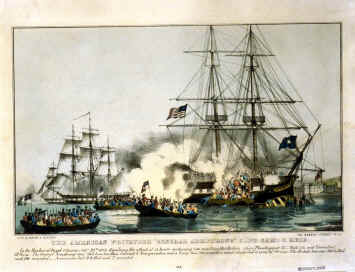
[Currier print]
A hand‐colored Nathaniel Currier print (before he joined with Ives, circa
1830s, from his shop in downtown NYC on Nassau Street. Color done by immigrant
girls, often German with some art education, each one applying a different color
in an assembly‐line fashion. )
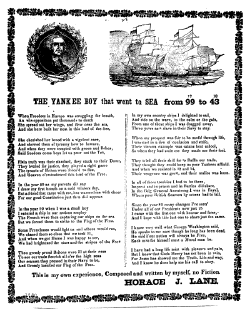
[Sheet music from 1843, "The Yankee Boy"]
The fourth from the last stanza reads,
In all of those troubles I had to be there
Imprest and in prison in Battles to share
In the Brig General Armstrong I was in Fayal
Where by scores British seamen had to fall.
A Senate Report published in 1880 concluded:
It is therefore evident that the heroic actions of Captain Reid and his brave
officers and crew saved New Orleans from conquest by England; for had the
British forces arrived even one week before General Jackson, they would have
captured the city, which was then utterly defenseless….
And in 1886, the Cincinnati Inquirer, published a spinoff:
It is therefore incontrovertible that the heroic action of the Armstrong saved New
Orleans from conquest by England; for had the British forces arrived even one week
before General Jackson, they would have captured the city, which was at that time
was utterly defenseless. (Cincinnati Inquirer, Jan, 1886)
Who else says so?
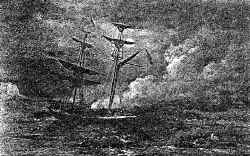
German painter Emanuel Leutze (who also painted "Washington Crossing
the Delaware")
did this rendition of the battle.
Historian John Van Duyn Southworth in The Age Of Sails: war at sea, says
General Andrew Jackson later told Capt. Reid that "If there had been no Battle of
Fayal, there would have been no Battle of New Orleans." Reid had delayed the
British expedition against New Orleans for ten days allowing Jackson to arrive there
earlier. Thus, Louisiana and the Northwest Territory might now be British if Reid had
not engaged them in what has been called one of the world's most decisive naval
battles.
When a young Teddy Roosevelt wrote his dissertation at Harvard on the Naval
War of 1812, he said:
The British squadron was bound for New Orleans, and, on account of the
delay and loss that it suffered, it was late in arriving, so that this action may be
said to have helped in saving the Crescent City. Few regular commanders could have
done as well as Captain Reid.
But was this merely an incident, now forgotten?
Just so it is clear that this continues down into recent times, if you look up
in Compton's Encyclopedia Online v3.0 © 1998 The Learning Company, Inc.
|
Reid, Samuel Chester (1783‐1861), U.S. Navy
officer, born in
Norwich, Conn.; commanded privateer General Armstrong in War
of 1812; in repulsing a British attack at Fayal, 1814, he
detained British ships
on their way to New Orleans, La., thereby enabling Gen.
Andrew Jackson to make adequate preparations to save the city
|
And this, from the U.S. Naval Institute Proceedings 1967 93(11): 157‐160:
|
Abstract of an article
Describes the defense the U.S. privateer General Armstrong
made against a superior British squadron in Fayal Roads,
Azores, in September and October 1814. The Americans
finally had to scuttle their battered ship, but the action
delayed the British squadron 10 days in arriving at Jamaica,
where they were to join the British expedition to attack New
Orleans. Thus the British arrived late at New Orleans, giving
General Andrew Jackson time to set up an adequate
defense of the city. Undocumented, 2 illus.
(bold face by this author)
|
And ultimately, this idea
was carved in stone:
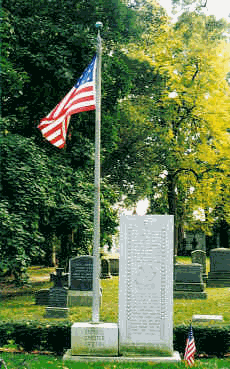 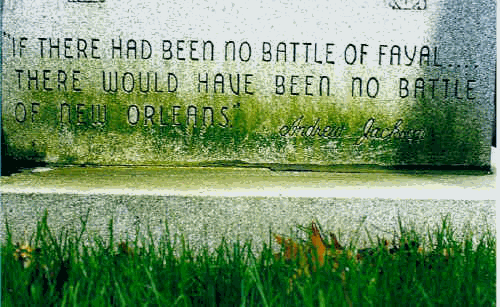
"If there had been no Battle of Fayal, there would
have been no Battle of New Orleans."
[Photos of Reid monument, Greenwood Cemetery, Brooklyn]
|
|
The speculation:
So I laid out the three lines from my aunt and all this accumulated
information I had found and it started to make sense. "If there had been no Battle of
Fayal, there would have been no Battle of New Orleans."
Well, with that kind of logic and a hefty admixture of speculation and
imagination, I began to imagine a sweeping drama. A friend suggested my ancestor could be
played by Mel Gibson with Charlie Sheehan as his brother. As for British commander Lloyd,
what a great, villainous role for Charles Laughton if he were still alive, or today
perhaps an even better role for Anthony Hopkins at his Hannibal Lector best.
This drama would perhaps begin at a moment in time when a dirty look by an
impressed Scotsman named Mackie, my ancestor, evolves into a string of circumstances
ending with the collapse of British hopes for empire in the Western Hemisphere and with
the rise of the American nation.
Without the details and spun from my aunt's brief notes, I began to
imagine, obviously more as fiction than as history, a scenario where

Click on the
map for a much larger image
[Speculative MAP]
-
The brothers, while fishing off the coast of Scotland, are taken and
impressed into the British Navy
-
They end up on Captain Lloyd's ship, (possibly the Guerriere
which was defeated by the USS Constitution very early in the War)
-
They are either among the prisoners in Boston or they jump ship,
possibly off the coast of Virginia or in Long Island Sound
-
Make there way to NYC, get jobs as ship fitters building the General
Armstrong with Noah and Adam Brown at the end of Houston Street on the East River
-
Sail with the General Armstrong on its many voyages
-
When British Captain Lloyd sails into the harbor in the Azores and
sees the General Armstrong, he spies the Mackies aboard. In a brief moment, as the
Plantagenet glides past the Armstrong, Lloyd loses his mind, swears to avenge their
desertion and to retake his former crewmembers no matter what…
I imagined entitling all this "Twist of Fate"
The questions:
Was it true? So while my curiosity about my ancestors, typical of
genealogical pursuits, was egotistical, self‐centered and vanity‐driven, the
subsequent questions this led to are perhaps of historical interest:
-
Why did British Captain Robert Lloyd attack the Armstrong when he had
other orders and despite being in a neutral port?
-
Did the attack really delay the assembly of the British expedition
against New Orleans?
-
Did the delay, as so many historians have asserted, really cause the
British to lose the Battle of New Orleans?
-
If the British HAD WON at New Orleans, would they have ignored the
Peace Treaty of 1814 and ruled the middle of America?
And if my ancestors, the General Armstrong, Reid, or Lloyd didn't delay
the British from starting the Battle of New Orleans, WHAT DID?
I will not be able to answer all these questions. Besides,
'what‐if' is not history. But examining them, I've found, reveals a
rich history of the Making of America and some examples of what research into primary
sources can reveal. I'd like to share some of this examination with you.
|
|
First, let me give you some background on the history and causes of the
War of 1812 and give some detail on Privateers and on Impressment:
A Short History of the War of 1812
The United States declared war on England in June of 1812. President James
Madison and the US Congress, especially southern and western representatives, felt it had
been treated with contempt by England and the cry was "Free Trade and Sailors'
Rights"
-
It was Free Trade versus Great Britain's Orders In Council
which required US ships to stop at a British port and get a license to trade on the
French‐dominated Continent ‐ a measure the British had taken as part
of the long and ongoing Napoleonic Wars.
-
It was Sailors Rights against Britain's impressment of
American seaman into the Royal Navy.
Though not a stated war aim, the conquest of Canada was a big factor.
Westerners and Southerners backed it. There were 5 attempts to do it. And none of them
worked out. Even tho Thomas Jefferson had said that the annexation of Canada to the US
"was merely a matter of marching." There were plenty of disappointments.
It's not easy to characterize the War of 1812. Let's say that if
the transatlantic cable had been operational 44 years earlier, this war might not have
begun at all, and it certainly wouldn't have ended as it did.
It was a war of disconnects, and of surprises.
For example:
-
A key cause, the squelching of free trade by the British
‐ The Orders In Council, were suspended in London just 3 days before the US
Congress declared war. We just didn't know it.
-
This is a war in which the Royal Navy outnumbers the US
almost 100 to 1. And yet London shipowners are begging for protection from
American ships‐in the Irish Sea and waters around the UK! And that, of
course, is where American privateers will come in.
-
This is a war in which an army gets to take and burn the
other side's capital city, Washington, DC. But it doesn't make much
difference.
-
Militarily, four of Britain's best, most
experienced generals, are killed on the field of battle on American
soil.
-
The most glorious land battle, at least to the
Americans, was fought over two weeks after a treaty of peace was signed: that is,
the Battle of New Orleans.
-
And after the Battle of New Orleans, the British go on
to take a key U.S. installation, the installation in Mobile Harbor which, if taken
on their first attempt two months earlier, probably would have led to a British
victory at New Orleans.
-
Before the year 1812, the United States could have as
easily have gone to war with France. Pickering claims that in 1795 alone the
French captured 316 American ships.
(cited in The Quasi‐War: The Politics and
Diplomacy of the Undeclared War with France 1797‐1801)
I'll shortly get to the very important issue of impressment, but
after extensive examination, I'd say that perhaps behind every war is national
attitude and nothing could be more true of the War of 1812:
British attitudes toward America
"First, it should be said that the entirety of the War of 1812 was very
small change in British minds; in London the real problem was Napoleon, not a gaggle of
far‐off and half‐baked ex‐colonials with an attitude."
(MARHST‐L)
After the war of 1812, an American was upbraiding an Englishman for his
ignorance of events: The American asked "Did you know that the British burned
Washington?" "No." said the Englishman, "But I know we burned Joan of
Arc."
Vice Admiral Sir Alexander Cochrane, British
commander‐in‐chief during the attacks on Washington and Baltimore and naval
commander of the expedition to New Orleans, wrote of the Americans, "They are a
whining, canting race much like the spaniel ‐‐ and require the same
treatment‐‐(they) must be drubbed into good manners." (Christopher
T. George) Quoted in Walter Lord, The Dawn's Early Light. New York: W. W. Norton,
1972, 35.
Possibly his hatred of Americans had a personal origin: his elder
brother, on October 17, 1781, had been standing next to Cornwallis at Yorktown, when his
head was shot off by an American cannonball. (Christopher T. George) We'll hear
more about Admiral Cochrane as he leads the naval expedition to New Orleans, which Lloyd
is to join.
Perhaps the most stunning event was the burning of Washington; but this
event has perhaps more to do with the needs of American patriotic feeling than strategic
necessity. Now, the British usually pass it off as payback for American burning of York in
Ontario. (York, it should be noted, is now Toronto.) However, the US soldiers had run amok
at York and that burning was against orders. But Washington was burned according to
orders and the London Statesman said, "The (KAH‐sacks) Cossacks
spared Paris but we spared not the capitol of America." and were joined by
some Members of Parliament. (Hickey). But when the news of the burning of Washington
reached London, there were celebrations and bonfires in the streets.
Now, in military history in general, if you capture your enemy's
capital city, you win the war; does that mean the capture of Washington D. C. meant the
British won the War?
Except for a few big, government buildings, Washington was a small town,
parts still swamp. Simply, it wasn't Moscow, Paris or London. The Government had only
been there for 14 years and congressmen called it "wilderness city," or
"Capital of Miserable Huts". There had even been talk of moving the Capitol.
But the burning became important in the American mind. Perhaps even more
important was:
Impressment
For America and American pride, perhaps the biggest single cause of the War
of 1812 was impressment. The Royal Navy, just between the years of 1803 and 1810, had
taken at least forty‐five hundred American sailors from US ships; students of the
Jeffersonian administration will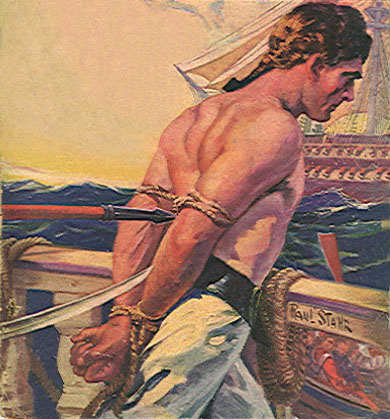 know of the USS Chesapeake incident in 1807 where
the Royal Navy forcibly took four sailors off a US Navy vessel and ended up hanging at
least one of them. know of the USS Chesapeake incident in 1807 where
the Royal Navy forcibly took four sailors off a US Navy vessel and ended up hanging at
least one of them.
Now, in all this, my ancestors would not have been among the more
than 6,000 Americans wrongly impressed into Royal Navy floating hells. As British
subjects, they would have been rightly and legally impressed into Royal Navy
floating hells.
During the peacetime that preceded the Napoleonic Wars, the Royal Navy had
about 10,000 men; by the War of 1812, the number had risen to 140,000. The overwhelming
majority of these men came from The Press. To maintain the navy's strength,
the press gangs were constantly at work. Not only did they have to replace men who were
killed or died in service, but they also had to replace the countless vacancies created by
desertion. Lord Nelson estimated that between 1793 and 1801 perhaps as many as 40,000 men
deserted the navy.
The British also boarded hundreds of American ships on the high seas,
hauling off droves of their own sailors who had deserted to the growing American merchant
fleet, which offered better pay and conditions. During a six‐year period through
1810, the more than 4,500 sailors the British snatched off American vessels, included
1,361 native‐born Americans, who were later freed with few apologies.
Madison's report to Congress, recommending war, said,
Under the pretext of impressing British seamen, our
fellow‐citizens are seized in British ports, on the high seas, and in every
other quarter to which the British power extends, are taken on board British
men‐of‐war and compelled to serve there as British subjects. In this
mode our citizens are wantonly snatched from their country and their families,
deprived of their liberty, and doomed to an ignominious and slavish bondage, compelled
to fight the battles of a foreign country, and often to perish in them.
Any English‐speaking sailor was in danger of being impressed.
Especially with a Scottish, Irish or English brogue. But it was all problematic because 25
years before, all Americans were English citizens. Until 1850, England did not
recognize the right of a man to renounce his nationality.
A case is reported where a Royal Navy captain listened to the protests of
a newly impressed sailor who claimed he was an American. The Captain looked down his
nose, "Why, you're nothing but a Scotsman!" (Durand)
During the War, 23 American prisoners of war claimed by Britain as its
subjects, some of whom had been naturalized in America, were sent to England for trial as
traitors, leading to threats of retaliation. The issue was resolved by stipulation in the
agreement of 16 July 1814 on the exchange of prisoners.
The US Government instituted Seamen's Protection Certificates beginning
in 1806 but the English said you could buy papers in any American port for a dollar.
And with the war against Napoleon, the Royal Navy was hungry for seamen.
Let me quote here the tail‐end of the story of the General Armstrong
in the Battle in the Azores; this is from a recounting done by the American
consul‐general on the island:
"Since this affair, the commander, Lloyd, threatened to send on shore
an armed force, and arrest the privateer's crew, saying there were many Englishmen
among them. …... At length, Captain Lloyd, fearful of losing more men, if he put his
threats in execution, adopted this stratagem:
He addressed an official letter to the Governor, stating that in the
American crew were two men who deserted from his squadron in America, and as they were
guilty of high treason, he required them to be found and given up." (Cogg / JOHN B.
DABNEY)
This was at a time when commanders of British warships patrolled the
Atlantic, short of seamen in their own ships, pressed American merchant seamen into
service. When boarding a U.S. ship for inspection, British officers frequently demanded a
muster of the ship’s crew in order to search for deserters.
This could have happened to my ancestors….
My ancestors and their crewmates might have been under just such a threat.
I've speculated that they may have changed their names for this reason and therefore
I could never pinpoint them in documents. But at least ‐‐ it's the
instigation for this pursuit in history
In Scotland, during the Napoleonic Wars, impressment was taken with
anguish but inevitably for granted. The Royal Navy press gangs ashore might do their
"recruiting" in daylight or at midnight at the local pub. But my ancestors as
fishermen would have definitely been 1‐A in the regulations called "Who the
Gang might Press". In Scotland in this era, some towns tried to mitigate the
randomness of the pressgang by having town elders confer and then offer up young men
without family obligations so the town wouldn't have to support the families of
pressed men. Here, of course, are the beginnings of The Draft Board.
According to Jerome Garitee's great book on privateering from
Baltimore, The Republic's Private Navy, American citizenship was required to
join the crew of an American privateer. All carried Seamen's Protection Certificates
‐ if one were found falsely issued, it would confirm the British presumption and
imperil the POW status of the entire crew.
My surmise is that my ancestors were "hot potatoes" as
un‐naturalized Scotsmen on the General Armstrong. If captured they may have been
identified by a British officer who would then use his discovery as a pretext for
grabbing many more sailors. For the Scotsmen, the penalty was not just
re‐impressment but hanging for desertion and high‐treason. If they had
papers, legitimate or otherwise, they may have flung them overboard. Or they may have
taken assumed names from the beginning.
Let me quote here A British/Canadian Perspective (Galafilm)
Sea power was Britain's pride and glory, and it was imperative to
its defense. In the early 1800s, Britain was engaged in a life‐and‐death
struggle with the Napoleonic Empire, and the Royal Navy was the only thing that
prevented Napoleon from crossing the Channel and conquering Britain.
Despite the navy's acute need for sailing crews, thousands of
British seamen chose to jump ship in favour of a more comfortable and profitable
position with the American merchant marine.
Wartime necessity justified the recapture of "deserters" from
any ship. Even deserters who had adopted the American nationality were not immune from
seizure as the Royal Navy adhered to a principle of inalienable British citizenship.
Besides, American citizenship certificates were frequently assumed to be forged.
An American Perspective
The British Royal Navy was a notorious floating hell. The pay was low,
when it was paid at all, shipboard conditions were miserable, and there was the
ever‐present risk of death or injury in battle. Small wonder then, that so many
British sailors chose to abandon the Royal Navy for the rapidly expanding American
merchant marine, which offered better pay and better conditions. ….and once the War of
1812 began, if a deserter could get on the crew of a fast American privateer and share
in it's prizes, why that would be going from Hell to Heaven.
When British commanders began to board American ships in search of Royal
Navy deserters, the Americans were highly offended. First of all, searching an
American ship was an insult to national sovereignty. Secondly, legitimate Americans
were sometimes "impressed" into British service on the pretext that they
were British deserters. As there were no obvious differences in physical appearance,
language or clothing, the British Navy was able to abduct as many as 6,000 Americans
in the early 1800s.
Again, the cry in the US was "Sailors' Rights and Free Trade"
with the human emphasis on Sailors' Rights ‐ that is, freedom from the threat
of impressment.
Now, as to the Heaven an impressed sailor could escape to …………
|
|
Privateers ‐who were they in military
history?
At the beginning of the War of 1812, the American Navy consisted of
about 16 major vessels, having in all 442 guns.
By contrast, the Royal Navy, tho focused mostly on Napoleon, consisted
of over 1,500 vessels of war. It was a Navy with 30 continuous years of conflict
behind it.
But during the fall and winter of 1812‐13, American privateers,
swarming the Atlantic, captured 500 British vessels.
Many people use the words pirate and privateer interchangeably but they
are not the same thing.
|
Navy
|
Privateer
|
Pirate
|
|
Was the government's seaborne force
|
Had government authorization ‐ a business venture
|
Independent
|
|
Destroyed, and sometimes captured the enemy
|
Captured declared‐enemy's ships
|
Captured targets of opportunity
|
|
Took & shared prizes too but not first priority
|
Split with the government
|
Kept it all
|
|
In war or peace
|
Only in war
|
In war or peace
|
|
Fought under its true flag
|
Never fired a gun under false colors, tho might approach with
one.
|
Usually fired a gun under false colors
|
A pirate was an individual who acted on his own, rather than in the
interests of a particular nation, and attacked almost any vessel on the seas for
his own gain, while a privateer usually acted for a specific country when that
country was at odds with another.
The privateer was used as a tool to economically and militarily hurt
another country. They were granted Letters of Marque, a license to attack enemy
ships without retaliation from the issuing country.
Simply, a privateer is a privately financed, owned, outfitted,
crewed, and operated armed vessel ‐‐ a private warship
‐‐ allowed forth under government license to attack the vessels of a
declared national enemy, for profit. Thus, unlike pirates, who are simply
criminal, privateers are quite legitimate. Also, their activity must cease with
peace; anything further indeed is piracy, and so recognized internationally.
Because the United States began the War of 1812 with 16 Navy ships,
the enlistment of 1,400 additional fighting ships ‐ privateers‐ by
War's end was important. There were complaints that the appeal and potential
profit of privateer service made it more difficult for the US to enlist crew in
the regular Navy but under some circumstances, the US Navy also took and shared
prizes too.
In New York City, what the dot.com business was to 1999, privateering
was to 1812
It was Patriotism AND profit ‐ sometimes big profits. A number of
investors could put up perhaps $40,000 (1813) dollars to build and arm a sloop (figure
$1.5 million today). The average prize proceeds were $116,712 per privateer (although
the privateer America took $700,000 = perhaps a hundred million today)
Here was a thoroughly incentive‐based system. After the US took a
portion, officers and crew generally received one‐half of all the proceeds
generated by the sale of captured ships and their cargoes, the other half was
distributed to the investors.
[Armstrong stock certificate]
Since most crewmen earned from two to four shares, this meant that in
the typical privateer cruise of three months, a man might earn the equivalent of
eighteen months' wages, and sometimes even more (Garitee 1977, 193‐94).
On the other hand, some privateers captured little or nothing or were
captured or destroyed themselves.
There's a wonderful paper by a Texas economics professor,
Larry J. Sechrest, on the web called Naval Warfare for Private
Profit. In it, he says,
Privateering was not a worthless anachronism. It was a
powerful method by which maritime nations could discourage aggressors without
indulging in the massive public expenditures needed to maintain a large public
navy. Indeed, it was, on occasion, publicly acknowledged to be more effective than
public navies.
In addition, since the British blockade and war in general had reduced
US imports to 10% of their pre‐war total, the captured English merchant ships
that the American privateers sent into NY, Baltimore, Charleston, etc., brought scarce
supplies to the American economy.
The war lasted about 31 months, a bit short of three years; in that
time, American privateers took some 1,800 British merchantmen, an average of about two
per day, 60 per month, and at times brought vital British sea trade to a virtual halt.
There was a time when British soldiers in the Peninsula Campaign in Spain were not
paid because of American privateers.
To show that everyone wanted to get into the business, I found at the
National Archives what looked like a Letter of Marque for a large rowboat. Sure
enough, I later found a record of an English merchantman with $20,000 worth of goods
on board, which was captured off George's River, by a row‐boat privateer,
and sent into a neighboring port. (Cogges)
Privateering goes back a log way. "by mid 1700s [privateering] was
carefully regulated, respectable and as law abiding as the navy," according to
Daniel Conlin, Curator of Marine History at the Maritime Museum of the Atlantic in
Halifax, Nova Scotia.
The British had privateers. So did the French and the Canadians. One
Canadian privateer waited off Cape Cod to snatch American merchantmen coming from
Boston.
It was not enough to build and outfit a vessel for privateering
activity, one also had to post a bond in order to guarantee compliance with
international laws of the sea. The intent was to make sure that privateers did not
degenerate into pirates. Such "letters‐of‐Marque" or
"surety" bonds were usually in the amount of either $5,000 or $10,000
Again, what distinguished a privateer from a pirate was its license, its
Letter of Marque.
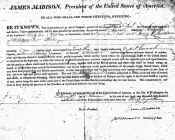
[Letter of Marque] authorizing James M. Mortimer Captain, and William
Ross Lieutenant of the said schooner Patapsco and the other officers and crew
thereof
to subdue, seize and take any armed or unarmed British vessel, public
or private, which shall be found within the jurisdictional limits of the United
States or elsewhere on the high seas, or within the waters of the British dominions
, and such captured vessel, with her apparel, guns and appurtenances,
and the goods and effects which shall be found on board the same, together with the
British persons and others who shall be acting on board, to bring within some port
of the United States;
I should also add, since we will later focus of those events leading up
to the Battle of New Orleans, regarding Pirate vs Privateer:
The famous Jean Lafitte and Dominique You were indeed pirates, that is,
high‐seas criminals, who, by fiat of Andrew Jackson, became, at least for a
time, not privateers but allies of the United Sates at New Orleans, primarily for
their artillery skills and their stocks of munitions. Lafitte, however, was back to
his old tricks in the Gulf of Mexico before long, as a pirate. (rr)
It should be noted that privateering is not necessarily a dead concept.
It still stands in the US Constitution, in the very same breath as the right to
declare war:
Article I, Section 8 of the Constitution states,
"The
Congress shall have power ... to declare war, grant letters of marque and
reprisal, and make rules concerning captures on land and water;
Let's talk about how they did that ……
|
|
[Privateers at war]
Technology
and armament in 1812
"Profit‐minded Americans had created a type of vessel especially well
suited to commerce raiding. It was a sort of schooner with ship or brig rigging. It had
speed and an uncanny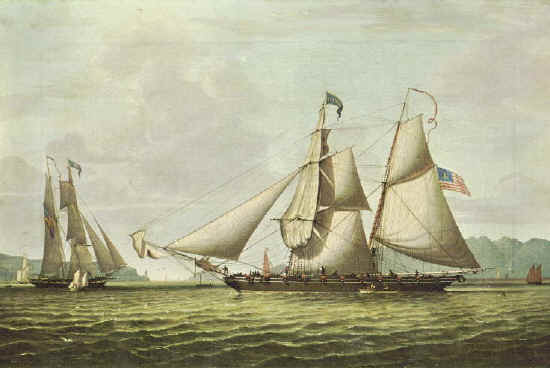 ability to seemingly sail up
wind. When heavier British vessels were closing in on it, they were often astounded to
see it virtually head into the wind and outrun them. It carried 16 to 18 guns and 90 to
150 sailors. It did not fight warships unless cornered, but outran them. On the other
hand, it could outmaneuver and outfight armed merchantmen. Royal Navy men of war
depended on largely sailing down wind. ability to seemingly sail up
wind. When heavier British vessels were closing in on it, they were often astounded to
see it virtually head into the wind and outrun them. It carried 16 to 18 guns and 90 to
150 sailors. It did not fight warships unless cornered, but outran them. On the other
hand, it could outmaneuver and outfight armed merchantmen. Royal Navy men of war
depended on largely sailing down wind.
The power that made all this happen, of course, was the wind. And it was
American perfection of a sailing ship that could make the most of the wind that
made her so surprisingly formidable.
These small, lightly armored schooners, built in Boston and Charleston
and especially in New York and Baltimore, were continuously perfected in design with
two objectives:
-
to get in fast, even into the middle of a British convoy, threaten
and then board an English merchantman and
-
to get away fast, outrunning the Royal Navy's strongest
men‐of‐war and the range of their longest guns.
In order to be fast, they had lots of sail, especially in relation to
their weight and size. If you look at a Royal Navy square‐rigger, you could see
that only wind from the rear or a rear angle could propel her forward. This wind
factor also had a lot to do with maneuverability. The Royal Navy was thinking of
gigantic gun‐platforms, the kind that would win for Nelson at Trafalgar.
The shape and arrangement of sails on an American privateer
schooner, brig or brigantine, are quickly movable to much more radical angles. English
seamen have written that they saw privateers escaping "sailing directly into the
wind."
The armament of these private armed vessels reflect their tactics. Unlike
the RN's gun‐platforms, a privateer needed only enough armament to
intimidate a lightly‐armed merchantman. The intent was never to face a ship of
the British Navy and win a gun battle. So the privateer would have 6 to 20 cannon on
each side and one or two "Long Toms". Because she was more maneuverable,
sailing so that the guns pointed in the right direction was something she could do
better than a man‐of‐war. (rr)
Of course, all this took place at speeds 2 to 20 miles per hour; it would
have seemed like magical slow motion if we had been there. (rr)
"General Armstrong', one of the most famous American
privateers, carried 8 long 9‐pounders, 1 long 42, and 90 men. She had taken $1
million in English property when cornered in September 1814 in the Portuguese port of
Fayal by 'Rota' and 'Plantagenet.'
This is not to say that American privateers were on an uninterrupted
course of triumph: human error and miscalculations intervened. Britain did an early
Q‐ship, disguising a well‐armed brig as a merchant ship and waited for
an American privateer to try to pounce. But, there are celebrated cases of the
privateer coming out on top, even in these circumstances.
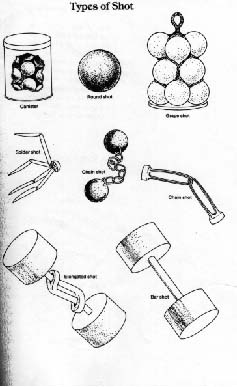
In this age of sail, it took some guts to engage in these showdowns. The
munitions were daunting and naval science of the day often measured the effectiveness
of a vessel of war in the weight of objects like these a ship could throw at an enemy:
The devices at the bottom were intended to bring down whole masts while
the nasty looking spider device in the middle was meant to tear sail,
all depriving the privateer's prey of its power.
[Instructions]
I also tried to determine how bloodthirsty and ruthless these
non‐pirate privateers were. George Coggeshall who wrote A History of the
American privateers and was himself a privateer captain, goes to great pains to
describe the gentlemanly‐behavior of these warriors:
These are instructions issued along with the Letter of Marque:
…2. …rights of neutral powers…You are particularly to avoid even the
appearance of using force or seduction
…3. Toward enemy vessels and their crews, you are to proceed in
exercising the rights of war,
with all the justice and humanity which characterize
the nation of which you are members….
EXTRACT FROM THE LOG‐BOOK OF THE SCHOONER HIGHFLYER, OF
BALTIMORE.
The Dolphin has taken six prizes without receiving the
smallest injury. She was repeatedly chased by the English, and at one time for
twenty‐four hours, but finally escaped.
She has treated her
prisoners with the greatest kindness. In rowing away from
men‐of‐war, she found great aid from their voluntary assistance. The
prisoners said they had much rather go to America than return on board a British
man‐of‐war."
|
|
For America, for privateers, for the Royal Navy, and for New Orleans,
perhaps
The fateful year was: 1814
August may have been the peak month of the War.
And a month in which many forces were at play
If you were there then, you probably would never have guessed
that the War would be over in six months or that the US wouldn't have
completely lost it and maybe its independence. Here's what I mean:
In August, British Navy ships ‐ from all over ‐
began their voyage to the rendezvous point in the Caribbean. Capt. Robert Lloyd
would have set sail from England.
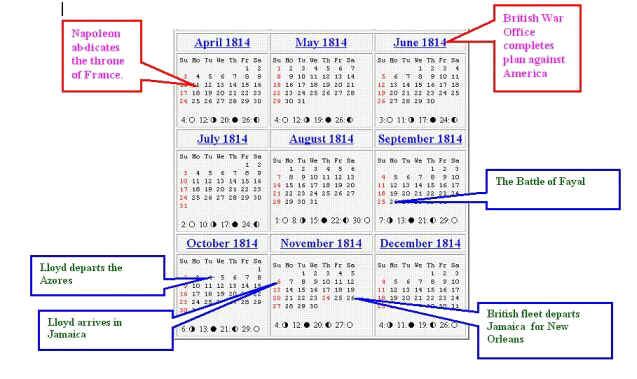
The Battle of New Orleans
New Orleans might be thought of as the southern prong of a
3‐pronged attack decided on by the British in the Spring of 1814, just as
Peace negotiations were getting under way. What we'd call today, "Combined
Operations"
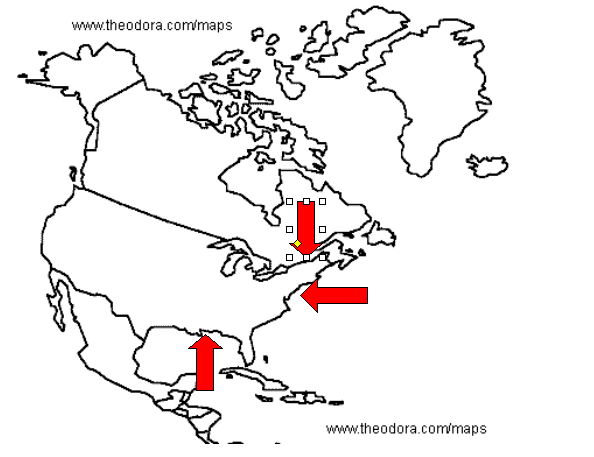
To bring the American nation to heel, the British cabinet worked out a
grand plan of conquest. The goal was "to destroy and lay waste the principal
towns and commercial cities assailable either by their land or naval forces."
The strategy consisted of a three‐pronged invasion from three widely
separated areas of the continent: an amphibian thrust into the Chesapeake Bay area
aimed at Washington, Baltimore, and other coastal cities; another from Montreal into
New York State via Lake Champlain; and a third from the Gulf of Mexico into
Louisiana with the purpose of seizing New Orleans and detaching the Mississippi
Valley from the Union.
But the biggest, best prize was to be New Orleans. Admiral
Cochrane's fifty‐ship armada initially carrying fifteen hundred
marines and 5,498 veteran troops sailed from Negril Bay, Jamaica. Other
units joined them near New Orleans.
Morale was high. So high that at Cochrane Hqs at Jamaica, the
New Orleans target was discussed in front of outsiders with US connections and
Cochrane's log records that it seemed the whole Island knew.
The New Orleans objective, in some ways, was no secret from the
start. In London, thruout the war, many allusions were made to this city as a
valuable prize.
There was an image in the British mind of the French, Spanish,
and Creole citizens of New Orleans being alienated from their new American
rulers. The Louisiana Purchase was only 15 years before. Statehood took place
just 45 days before the outbreak of the War.
My main concern here was not with the land Battle of New
Orleans but rather the expedition. How it was planned, how it assembled. What
actually happened as it progressed. Did the fight with the General Armstrong really
delay the assembly of the British expedition against New Orleans?
Some conclusions
Now I was in a position to deal with some of the questions which
initially arose.
Why did British Captain Robert Lloyd attack the Armstrong when he
had orders to join the New Orleans expedition and despite being in a neutral
port?
In addition to all my fascination with the prospect that my ancestors
were on the General Armstrong, I also became deeply intrigued with Robert Lloyd, the
British captain who commanded the squadron that sailed into the harbor in the Azores
that September evening.
He was under orders. Important ones. For the big strike at the
American underbelly.
But here was possibly a Captain on‐the‐edge. Perhaps he
had been viewed like numerous British captains who had risen thru the ranks: one
Naval observer complained about the "means of bringing persons of obscure birth
into undue distinction," ‐‐ many sailors made their fortunes and
ranks through the capture of enemy ships.
HMS Plantagenet in three months captured 25 small American ships along
the NE coast.
I found four other intriguing events which have been recorded
as having occurred while Lloyd commanded the Plantagenet:
1. The London Statesman, in 1813 published an article which
seemed to imply that Lloyd had failed to pursue an American warship off the coast
of Maryland.
2. During most of the war, the USS Constitution was bottled up in
the Chesapeake. In an attempt to clear the blockading British ships, Edward Mix of
the US Navy attempted to target the Plantagenet with the world's first use of
"fish torpedoes" ‐ that is, a submarine. The explosion took place
within view of Lloyd's ship. (Forester)
Really intriguing but without a full explanation was a recorded
incident where
3. During a hit‐and‐run attack from British blockaders
along the Connecticut coast where HMS Plantagenet stood "on the American
station", five Englishmen were captured by local militia. They gave their
"parole", that is, their word they were out of action for the duration
or until exchanged. They were discovered back in action shortly thereafter. One of
the ‐ apparently ordinary seamen, marines or junior officers ‐ had
given his name to the militia as: Robert Lloyd. (History of Stonington).
4. When Lloyd arrived at Jamaica, he sent a letter to Admiral
Cochrane, asking for a court‐martial. I made great effort to follow this up
and failed. Did he want to clear his name over the Battle of Fayal and the loss of
so many men?
Were this drama, we could build a wonderful villain.
Herodotus, known for his double roles as an historian and
a spinner of yarns is supposed to have said ‐ referring to events in history
‐ "Very few things happen at the right time and the rest do not happen at
all. The conscientious historian will correct these defects."
Now, as I looked over these materials, doubts began to creep into my
speculations.
Some Doubts
Before, I showed a hand‐colored Nathaniel Currier print
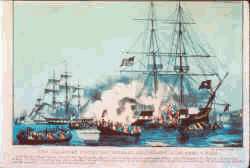
But this illustration betrays a number of inaccuracies:
-
In spite of the sky, all accounts agree that the battle was fought
after dark and the multiple boat attack after midnight.
-
The legend inscribed below has the date in October ‐ wrong
by a month.
-
Also, The General Armstrong was not a square‐rigged vessel.
And remember the 1886 Cincinnati Inquirer piece I
quoted?:
It is therefore incontrovertible that the heroic action of the
Armstrong saved New Orleans from ….
-
Fine, except that this article had the British arriving at New
Orleans direct from Waterloo,
though that actually happened 5 months
later,
-
and it talks about Lord Castlereagh as British Prime minister,
when he was actually Foreign Secretary.
So despite all the 19th century hype and the readiness with
which a number of sources have credited The General Armstrong with having delayed
the invasion and assured American victory, I have hopefully cast a skeptical eye on
this.
|
Did Lloyd's attack on the General Armstrong really delay the
assembly of the British expedition against New Orleans?
As I thought about it, it occurred to me: Why should it? Lloyd had
only 3 ships out of 50 in the expedition?
Now, it is true that it could take 8 or 10 weeks to get from
Plymouth to Jamaica.
Westerly voyages took longer, the Gulf Stream was against
you…sailors called it "sailing uphill". He might have run into autumn
storms and hurricanes
It's worth noting that British morale was high in Jamaica before
they left for New Orleans. Higher officers wives accompanied them. The New Orleans
objective was referred to as "Booty and Beauty
". The Beauty for the doe‐eyed Creole girls
and the Booty for the New Orleans warehouses
full of cotton and perhaps $15 million worth of goods. The British Treasury and
economy were broke. A threatened renewal of the property tax had awful political
implications. (Perhaps another theory and another paper, or perhaps just a
contributing factor?)
General Packenham, the Army commander, didn't arrive until the
fleet was at New Orleans meaning they started from Jamaica without him.
This told me a lot about cross‐Atlantic movement: British
General Edward Packenham was appointed to command the land forces and work with
Admiral Cochrane, who was in Jamaica. He was to replace General Ross who was
killed by American riflemen outside Baltimore after the burning of Washington.
Word of this needed‐change didn't reach London until
mid‐October and Packenham was appointed on October 24th and
departed Plymouth on October 28th with General Gibbs, to be his second
in command. (They were both to die, like Ross, shot by American marksmen.)
On their voyage to join the New Orleans force, the elderly
Captain of HMS Statira (STAH‐tir‐ah) shortened sail every night.
The passengers urged him to make all possible speed. But the captain is the
captain. (Brown)
They were 7 weeks to get to Jamaica. Cochrane's fleet had left.
Packenham and Gibbs arrived at New Orleans on Christmas Day, after the first
actions with the Americans.
So Packenham was late. And that, truly, may have effected the outcome
of the Battle of New Orleans.
Did a delay, as so many historians have asserted, really cause the
British to lose the Battle of New Orleans?
The evidence clearly suggests that if the British had arrived at New
Orleans earlier and moved more quickly, the city would have been theirs. Here the
answer is probably yes.
One interesting speculation relates to a letter written by Wellington
after the war, charging that British Naval Commander Cochrane advocated the project
against New Orleans for the purpose of plunder (that estimated $15 million in cotton
and goods in New Orleans' warehouses) and then led the army through Lake Borgne
into a trap. Combine this idea with several recorded complaints that the British
expedition had numerous transports heavy with ballast which traveled slowly to the
rendezvous in Jamaica: Ships loaded with ballast in the expectation the ballast
would be replaced with the booty of New Orleans. Wellington was saying that the
Royal Navy, in its quest for its own prizes, for greed, got his
brother‐in‐law killed.
We've also heard from John Buchanan about Jackson and Horseshoe
Bend ‐ ‐
Had the Creek civil war been delayed and
synchronized with the landing of the British troops, the combined forces might well
have overcome Jackson's army and gone on to capture New Orleans and the lower
Mississippi Valley.
But my research brought me back to a more basic, simple question
‐
When did the British Navy plan to rendezvous to attack New Orleans?
This was a big operation. More ships than at Trafalgar.
My great discovery was the original War Plan ‐ written in
London in the Spring ‐ and dated 20 June 1814:
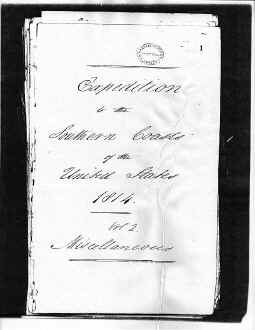
|

|
 "…should meet
at the said rendezvous not later than the 20th of
November."
"…should meet
at the said rendezvous not later than the 20th of
November."
|
|
So as far back as June, the planned rendezvous date
was set to November 20th This date was never changed; subsequent documents
emphasized that these instructions were firm . The advantage Jackson had,
in addition to good intelligence, was simply that the long‐before planned
date was set
so late
. The British, in fact, did complete the rendezvous
by November 20th and departed Jamaica for New Orleans on November
26th, including Lloyd and the ships that had fought the General
Armstrong in Jamaica two months before.
But the final blow to the contention of so many historians, and of
Andrew Jackson, Teddy Roosevelt and the U.S. Naval Institute Proceedings,
(not to mention my fantasies about the impact of my
ancestors)
came when I finally saw the log of Royal Navy Captain Robert
Lloyd's ship, the Plantagenet.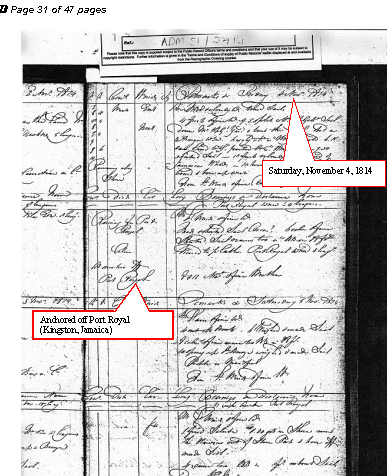
In fact, it shows him leaving the Azores on October 5th,
eight days after the battle.
But even more importantly, it shows him arriving at Port Royal, just
outside Kingston, Jamaica just one month later, on November 4th,
In plenty of time for the Battle of New Orleans,
in complete contradiction of the American legend.
In other words, LLOYD WASN'T LATE! In fact, he
was early!
If the British HAD WON at New Orleans, would they have ignored the
Peace Treaty and ruled the middle of America?
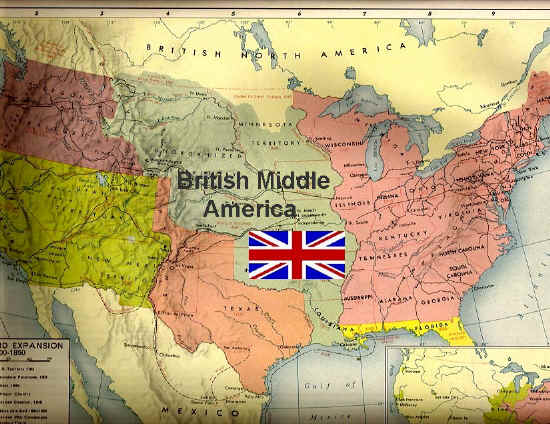
There is SOME evidence to suggest this, more than I think is usually
acknowledged.
I found that it was less than an elaborate and systematic plan of
action. And that British opinion, public, military, political were all split in
that Autumn of 1814.
In mid‐Autumn, American negotiators John Quincy Adams and John
C. Calhoun at the peace talks at Ghent in Belgium were somewhat mystified when,
out of the blue, the British negotiators began to allude to a previously
unmentioned document:
the
Treaty of San Ildefonso.
The Treaty of San Ildefonso
‐‐‐‐‐‐ denied the right of the
now‐deposed Napoleon to dispose of Louisiana to any state other than Spain.
As historian Edward Channing said, the US was "the purchaser of stolen goods
from a known highwayman." (Brown) Strict international law would have upheld
that the US had not legally purchased the Louisiana Purchase.
John Moser, Department of History at the University of
Georgia Wrote on H‐Net:
This is true, but
that's not to say that the battle had no effect on the peace, for it in
large part determined how the Treaty of Ghent would be interpreted by the
British. Under the terms of the treaty, the British would have been within
their rights in withholding recognition of the Louisiana Purchase, or of
American claims to the Gulf Coast. Had the British won at New Orleans,
Britain would almost surely have turned the city back over to Spain. Monroe
realized this, and said as much to Madison. The net effect of Jackson's
victory, then, was nothing less than the international legitimization of the
Louisiana Purchase in the eyes of the Great Powers.
The logic of the propaganda ‐ ‐ that the General
Armstrong saved New Orleans and the Middle of America from British rule ‐ is
consistent with how military information was dealt with by the Public and Press
‐ most especially naval information of the time. For example, in the first
two months of the War, we can witness the case of US Army General William Hull and
his nephew US Navy Captain Isaac Hull ‐ the uncle tries to invade Canada and
loses everything ‐ the nephew sails out with Old Ironsides, destroys a
smaller British vessel.
The American public, faced with concluding they had either just
declared a foolhardy war, based on a failed invasion of Canada,
or a war where they were certainly going to tweak the British
bully's nose, based on this victory of the USS Constitution vs HMS Guierriere,
the American public and press, of course, opts for the latter, and a triumphant
posture.
|
|
What happened to:
OUTCOME ‐ what happened to them all? Now that I've told
you the story, I have to tell what happened to all these people:
Andrew Jackson
General Andrew Jackson’s stunning victory over crack British
troops at Chalmette on January 8, 1815, was the greatest American land victory of
the War of 1812.— the last battle of the last war ever fought
between England and the United States—it preserved America’s claim to
the Louisiana Purchase, prompted a wave of migration and settlement along the
Mississippi River, and restored American pride and unity. It also made Jackson a
national hero
Thomas Fleming ‐ one of our favorite speakers, wrote :
"He was able to parlay his popularity into a political
base of power that propelled him to the presidency in 1828. As Jackson was leaving
the White House at the end of his second term in 1837, a congressman (perhaps a
wise guy, trying to needle him?) asked him
‐‐‐‐‐ had there been any point to the Battle of
New Orleans? After all, it had been fought after the peace treaty was signed. The
old warrior gave him one of his patented steely glares and said: "If General
Pakenham and his ten thousand matchless veterans could have annihilated my little
army...he would have captured New Orleans and sentried all the contiguous
territory, though technically the war was over....Great Britain would have
immediately abrogated the Treaty of Ghent and would have ignored Jefferson's
transaction with Napoleon."
Was he right? We will never know for certain. Old Hickory settled the
argument in advance by winning the battle." again from Thomas
Fleming's article on Jackson on the web ‐ see my bibliography.
The War
'Uti posseditis', is the Latin phrase
that means "you keep what you conquered" as opposed to "status quo
ante bellum" ‐ "the way it was before the war". In the
negotiations at Ghent, America had successfully opposed Britain's attempt to
sign a treaty where they'd hold onto conquered US territory. Did they know
about the massive fleet assembling for New Orleans? And yet, Britain gave way and
agreed, in essence, to the evacuation of US Territory ‐ without any news
from New Orleans. Why?
In the Spring of 1814, the Duke of Wellington had urged a
settlement. Faced with the depletion of the British treasury due in part to the
heavy costs of the Napoleonic Wars, and privateers in British waters, the
negotiators for Great Britain accepted the Treaty of Ghent on December 24, 1814.
It provided for the cessation of hostilities, the restoration of conquests and a
commission to settle boundary disputes.
…so, the Peace Treaty was signed on Christmas Eve, 1814. Good thing,
too. The War was ruining the economies of both the UK and the US. In New York City
in early February, on a dark winter night, a ship with an American and a British
diplomat brought the news. From the downtown docks, after dark, the word began to
spread thru the icy city; candles in celebration began to appear in the windows up
and down lower Broadway.
The United States had ended hostilities without losing any
territory and asserted its status as an independent nation that would no
longer stand for the violation of its neutral rights or the humiliation of
impressment. Perhaps the best measure of the impact of the war is how
Americans learned from the experiences and mistakes of the war and applied
those lessons to postwar America. After the war the United States reorganized
the Army, Navy, and War Department to correct the defects revealed during the
War of 1812. In his message to Congress in December 1815 President Madison
acknowledged the financial difficulties caused by the lack of a national bank
and the supply problems caused by the poor conditions of American roads, and
he recognized the value of American domestic manufacturing, stimulated by the
trade disruptions of the war. Madison's recommendations that Congress
approve a national bank, federal support for transportation and internal
improvements, and protective tariffs were all enacted in the years immediately
following the War of 1812. Americans also emerged from the war with a message
to the world that their experiment in republicanism had been proven
successful.
Jayne Triber
Only the Indians, that the Treaty made some effort to consider, lost
land.
Three of our great icons ‐‐ the Star Spangled Banner,
"Old Ironsides," and Uncle Sam ‐‐ date from this war.
With the final defeat and removal of Napoleon,
impressments
as an Admiralty system was not needed and largely ceased to exist.
Though the U.S. gained none of its avowed aims, popular legend
soon converted defeat into the illusion of victory. Several circumstances
contributed to this process: the series of military successes in the
war's closing months created a sense of victory The war also marked a
decline of U.S. dependence on Europe and stimulated a sense of nationality. EB
article
It demonstrated enough resilience to force the
British to look at
the United States as something other than a
renegade colony, and perhaps helped to lay the groundwork for the
rapprochement later in the century. It may also have played a part in the
British willingness to compromise on the issue of the North West territories
in the 1840's possibly averting another war. In a sense, the War of 1812
might have ended the last external threat to the survival and growth of the
United States [the issue of slavery being an internal threat] until the
development of Soviet nuclear capabilities in the Cold War.
British Naval Commander Admiral Alexander Cochrane
While awaiting a replacement for Ross, Cochrane had commenced the
attack against New Orleans. On December 14, his forces captured the American
gunboats on Lake Borgne. The British subsequently advanced through Bayou Bienvenu
to within seven miles of the city by December 23. But the British attack on
General Andrew Jackson's army ultimately failed and Cochrane's Navy
withdrew with the rest of the British force.
He got most of the British brigades back in time for the Battle of
Waterloo.
Cochrane died in Paris on January 26, 1832.
British Army Commander Sir Edward Packenham ‐
On January 8, 1815, on the field of Chalmette, a few miles before
New Orleans, "whole platoons were mown down as with a scythe; but the gallant
army continued to press forward until officer after officer was killed, and
Pakenham himself fell, bleeding and dying…." (MOA)
He was shot by a Tennessee marksman from behind bales of cotton.
Like General Ross from Baltimore, some say, he is shipped home to England in a keg
of Jamaican rum (a variety of stories, and jokes, have spun out of this method of
preservation.) So like General Ross at Baltimore, he was shot by an American
sharpshooter and he died attended by the same staff aide as Ross, Captain Duncan
MacDougall
British man‐of‐war Captain Robert Lloyd
‐ who started the fight in the Azores. He was given
the honor of bringing back to England from the Battle of New Orleans, the body of
General Sir Edward Packenham. Before the Napoleonic and 1812 Wars, Lloyd had
earlier been, and after became again, a sheriff in Wales on the island of
Anglesey.
At one point, I found a distant cousin of my villain on a Welch
genealogy forum. In hopes of getting more, I posted a request for information.
Hoping to appear both honest and scholarly, I added in my request for more
information:
"I must now caution you that some of this research focusing
on Robert Lloyd tends to characterize him as a villain and, perhaps, as a man
who lost his temper and thus changed the course of world history. You can see
more at my website. ( http://bobrowen.com/warof1812/)
But I would hope you find it interesting as a far‐reaching tale of
turbulent times and as an unearthing of a most significant son of Anglesey. I
will apologize in advance for any residue of American jingoism in this
material from the period."
Well, it did me no good, I got no replies, and you get the feeling
the Welch are happy to leave their confrontational Royal Navy Captain behind.
Privateering in General
Today, there are known cases of piracy in the South
China Sea but as for privateering ‐
Members of NYMAS will, of course, know about
… Imperial Germany in WWI (especially the famous SEEADLER, an armed
sailing barque skippered by the humorous Kapitan and Graf Felix Von Luckner)
‐‐
and especially the Plan of Nazi Germany in WWII, in arming and
sending out numerous disguised merchantmen as naval raiders worldwide to attack
Allied merchantmen.
The United States is not a party to any instrument which explicitly
renounces privateering. The U.S. is a party to some of the Hague Conventions of
1907 which, by implicit incorporation of the 1856 Paris Declaration, have been
construed to reaffirm the principle that "privateering is, and remains,
abolished." (H‐DIPLO)
The General Armstrong
As far as I know, The General Armstrong still lies in the harbor in
the Azores, altho the Long Tom pivot gun was rescued; the massive iron
42‐pounder gun ‐‐ a monster weapon for its day
‐‐ eventually was acquired by the Navy Museum at Washington Navy
Yard.
What didn't go away for a very long time was a series of
lawsuits and claims, both nationally and internationally. In 1852, the French
Emperor Napoleon ruled against the US simply because the crew of The General
Armstrong had fired first on that evening in September in 1814.
Captain Samuel Chester Reid, Captain of The General Armstrong
‐
Whatever doubts I've cast on the mythology of the General
Armstrong, Captain Reid and his crew were very brave men and tho cornered, stood
up to an attack others would have withered under.
The hype, and I don't know what else to call it, that the
General Armstrong changed the outcome of the Battle of New Orleans, perhaps tells
us more about the psychological needs of America.
An underpopulated, new nation, fighting a contemptuous former ruling
country and King, needed to feel it had sway over wide ranging events.
Reid became harbormaster of the Port of New York in 1843. (LC) and
passed away in obscurity in Brooklyn on the eve of the Civil War in 1861.
In 1956, his unmarked grave was found at Greenwood Cemetery ‐
the Stonemasons erected an imposing monument, lauding Reid as designer of the 1818
flag and esp. as Captain of the Armstrong‐ and on the base of it, carved in
stone, is ‐
"If there had been no Battle of Fayal, there would have
been no Battle of New Orleans." ‐‐ Andrew Jackson
We've all heard that "the first casualty of war is
truth." Perhaps, in this case, it was the last casualty.
As for my ancestors, the Mackies
Frankly, I loved the idea that my
great‐great‐grandfather might have changed the course of world
history…and the idea of informing my cousin in California that if it weren't
for our ancestor, on his next trip east, he might be flying over British Middle
America.
But now I must tell you that on my last day of researching American
privateer Captain Reid's family papers at the Library of Congress, I finally
found the crew list for the fateful voyage ‐‐ and there were no
Mackies on it.
But the search launched this, to me, wonderful expedition
you've heard about tonight.
Don't know what happened to the other brother, but the first,
John Hewitt Mackie, settled initially in New London, CT, then across the Sound in
Greenport, LI. He married an Irish girl, as would his grandson. He and his son
worked as ship riggers, then the son struck out on his own, (possibly with
Congressional bounty money from the father that Reid had pressed for), and
acquired a clipper ship plying trade to China and then within China. Alas, sail
was overtaken by steam and there were possibly complications relating to the opium
trade, so that by the end of the 1800s, the family was in Bridgeport, CT and
growing children were taking jobs in factories.
It was in this era that these Scotsmen met the Irish branch of the
family. Our Irish matriarch didn't like the Scottish branch when she met them
and held that they were "adventurers and dreamers". In fact, she stood
in the way of the marriage and my grandfather and grandmother eloped. But
turn‐of‐the‐century convention reigned, they had five
children, this Mackie became a florist and they never, ever mentioned
privateering; it took John Hewitt Mackie's grandson's brother to reveal
to the young niece, my aunt, the details you heard about at the beginning of the
story:
|
Two brothers, conscripted off Isle of Skye, Scotland,
on English man of War to America.
Both brothers helped build privatier Gen. Armstrong
War 1812.
They stayed with the ship until wrecked.
|
Me? I learned that history, like Roshomon, has many points of view.
And just as Andrew Jackson, Teddy Roosevelt and the Naval
Proceedings got to spin their myth, so did I.
As for the historical legend of The General Armstrong and its effect
on the Battle of New Orleans, I am reminded of Shaw's The Devil's
Disciple. I remember well the 1959 movie version with Lawrence Olivier as
Gentleman Johnny Burgoyne who, when told he'll have to surrender to the
Americans, because of a bureaucratic error in London, is asked by his aide:
"Sir, what will history say?"
Burgoyne replies with great British arrogance:
"History, Sir, will tell lies, as usual."
Sir George Bernard Shaw,
The Devil's Disciple (1901), Act 3
END
|
|
Resources
A short Bibliography for American Privateers in the
War of 1812
On the Web
My own site with primary sources: http://bobrowen.com/warof1812/
The War of 1812 Casebook site is not to be missed,
especially the "British Views of the War of 1812 in the Chesapeake"
by Christopher T.George at http://warof1812.casebook.org/articles/dissertation.html
An absolutely splendid and detailed history on the War of
1812, causes, battles and personalities is at Galafilm http://www.galafilm.com/1812/e/index.html
(they made a four‐part TV documentary on the subject; part of what can
only be described as a Canadian renaissance of interest in the War of 1812.)
Part of MilitaryHeritage.com is their War of 1812 Website. Lots of
detail about uniforms, ordinance, and battles in the north ‐
conspicuously from a Canadian point of view.
That wonderful Tom Fleming article on Jackson is at the
Military History Quarterly website at Old Hickory's Finest Hour ‐
Cover Page: Winter '01 MHQ ...
www.thehistorynet.com/MHQ/articles/2001/winter01_cover.htm
‐ 9k
Books
Best single, small book on the War: Coles, Harry Lewis,
1918‐ The War of 1812, Chicago, University of Chicago
Press [1965]
My nomination for most readable, but good on scholarship,
is Lord, Walter, 1917‐ The dawn's early light /:
Johns Hopkins University Press, 1994. 384 p. : ill., maps ; 22 cm.
I think, by far, the best book on the Battle of New
Orleans is: Carter, Samuel, 1904‐ Blaze of glory; the fight for
New Orleans, 1814‐1815. New York, St. Martin's Press
[1971. The only trouble is Blaze of Glory may be hard to
find.
Also excellent is: :Brown, Wilburt S., 1900‐1968. The amphibious
campaign for West Florida and Louisiana, 1814‐1815; a critical review
of strategy and tactics at New Orleans. University, Ala., University of Alabama
Press [1969] xii, 233 p. maps. 26 cm.
Hickey, Donald R., 1944‐, The War of 1812 : a forgotten conflict /
Donald R. Hickey. Urbana : University of Illinois Press, c1989. xiii, 457 p. :
ill. ; 24 cm.
Recent and more popular is Remini, Robert Vincent, 1921‐, The Battle of
New Orleans / Robert V. Remini. New York, N.Y. : Viking, 1999.
Valuable for its details is Mahan, A. T. (Alfred
Thayer), 1840‐1914. Sea power in its relations to the War of
1812. New York, Haskell House, 1969. 2 v. illus., maps, ports. 23
cm.
Privateering is covered by a contemporary who actually
captained a privateer himself: Coggeshall, George, 1784‐1861.
History of the American privateers, and
letters‐of‐marque, during our war with England in the
years 1812, '13, and '14. Interspersed with several naval
battles between American and British ships‐of‐war. By
George Coggeshall ... 3d ed., rev., cor. and enl. New York, The Author,
1861. lv, 482 p. front. (port.) plates. 22 cm. Reprints available and you
can read it or download it from the splendid Making of America site at the
University of Michigan at http://moa.umdl.umich.edu/
Prof. Larry J. Sechrest apt paper Privateering and
National Defense: Naval Warfare for Private Profit is at http://www.independent.org/tii/WorkingPapers/Sechrest6.html
aa a pdf file.
Pronunciation:
Cockburn = CO‐burn
Cochrane = COCK‐run
Packenham = pack‐EN‐am
Special acknowledgements:
Don Canney, official Historian of the United States
Coast Guard.
Kay Larson, of NYMAS and National Historian of the
USCGA who took time from her schedule to help with myriad issues.
Philip S. Goodman's for his invaluable
assistance and guidance.
Frank Radford for his Naploeonic expertise on the
British and European perspectives.
Norman Brower of the South Street Seaport Museum
Library helped pinpoint detail of the era.
Altho Norman Friedman has dozens of books on naval
history to his credit, he was kind enough to give this amateur history
buff direction.
Bob O'Hara, who lives in Kew, London, outside
the gates of the Public Record Office, and is a top professional
researcher.
Thanks to Joseph C. Abdo whose paper from the I
Congresso Internacional de Estudos Anglo‐Portugueses 6‐8
Maio de 2001 Lisboa on the US Consul Dabney's family was an
important resource.
And to Alice Galassi, great‐granddaughter of
the General Armstrong's valiant Captain Samuel Chester Reid.
And last but not least, to Christine Enright Snyder,
the cousin who supplied the three lines from her mother, without whom
this paper would not have been written.
|
|
Topics for Discussion
+ Misc. outtakes
I did a lot of research ‐ learning how a real historian might
do it ‐ but was able to get almost 50% from the web.
Dates, times and places don't agree in primary sources.
I have some evidence that in the 1812 Battle between the
Constitution and Guerrière, Lloyd was a subordinate officer on the Guerrière which
might have created a situation where the British officers would have hated capture
by the Americans but the crew, especially impressed crewmembers, would have loved
it. And would willing sailors been allowed to escape becoming POWs and perhaps
join the US Navy…or privateers?
In August 1814 the 93rd sailed to Plymouth, England thinking of
home. Instead on 17 September they embarked on three ships as part of a
three‐pronged offensive designed to chastise the United States and end the
war dragging on there since 1812 when the U.S. declared war and invaded Canada.
Napoleon had been sent into his first exile. Tens of thousands of veteran British
soldiers were now free to be used in America. One prong of this strategy would
attack through the Great Lakes region, the second front would smash into the
eastern seaboard ultimately to burn the capital of Washington in retaliation for
U.S. forces burning York (Toronto), Canada. The third ‐ with the 93rd
aboard ‐ would attack through the Gulf of Mexico. Their final destination:
New Orleans.
The 93rd Sutherland Highland Regiment of Foot 1800 ‐ 1881
(was John Lambert with Capt. Lloyd at Fayal?)
|
In short, I was never able to find proof, beyond my
aunt's notations from her great uncle, that my ancestors had
actually been on the General Armstrong. They would have had reason to
adopt assumed names or be given aliases by their Captain and crew, but
for evidence, that's like proving a negative. In any case, it
launched for a me a time travel over Europe, the Atlantic, the
very‐young United States to the bayous around New Orleans. I went
to college in New Orleans and Lafitte's Blacksmith Shop and the
Napoleon House were very regular hangouts…yet I knew almost nothing of
their history…as I knew almost nothing of this neglected period in US
history.
|
Washington appointed Pierre L'Enfant to plan the new
city and three commissioners to be in charge. The commissioners dubbed the
city Washington. In 1793 the president laid the cornerstone for the
Capitol. In October 1800 the government moved from Philadelphia. The
district was still largely remote. Many called it "Wilderness
City." Not until British troops forced them to defend it from burning
in 1814 did Americans develop a proud attachment for their capital.
continued
Washington Encyclopedia Britannica Article
Aaron Burr wrote an unsolicited letter to a NY newspaper in 1817.
(LC)
Mackies, change name, Chesapeake incident even before war, one hung,
while Goya was drawing the horrors of Napoleonic warfare in Spain.
|
1814
British undertake a three‐part invasion of the
United States at Chesapeake Bay, Lake Champlain and the mouth of the Mississippi
River. British troops are repulsed at Baltimore harbor after capturing Washington and
burning the Capitol buildings.
January 22 ‐ Battle of Emuckfau.
January 24 ‐ Battle of Enotachopco Creek.
March ‐ British‐French war ends with
British victory. Britain can now concentrate on the war with the United States.
March 27‐28 ‐ The Creek Indians are
defeated by Andrew Jackson at the Battle of Horseshoe Bend
April 11 ‐ Napoleon abdicates the throne of
France.
April 14 ‐ Embargo and Non Importation Law
repealed by United States.
April 25 ‐ British blockade extended to New
England.
July‐September ‐ Eastern Maine occupied by
British forces.
July 3 ‐ Americans capture Fort Erie.
July 5 ‐ Battle of Chippewa.
July 25 ‐ Battle of Lundy's Lane.
August ‐ American public credit collapses. Banks
suspend specie payments.
August 8 ‐ Peace negotiations begin in Ghent with
the British outlining initial peace terms.
August 9 ‐ The United States and Creek Indians
sign the Treaty of Fort Jackson.
August 14 ‐ British forces occupy Pensacola.
August 15 ‐ Battle of Fort Erie.
August 24 ‐ Battle of Bladensburg.
August 24‐25 ‐ Washington, DC burned by
British forces.
August 28 ‐ Nantucket declares neutrality.
September 11 ‐ Battle of Lake Champlain. American victory over a
larger British force at the Battle of Plattsburgh secures the U.S. northern border.
September 12 ‐ Battle of Mobile Bay. Battle of
North Point.
September 13‐14 ‐ Battle of Baltimore.
The Star Spangled Banner is written by Francis Scott Key.
September 17 ‐ American forces sortie from Fort
Erie.
September 26 ‐ General Armstrong captured by
British.
October 21 ‐ Peace on basis of uti
possidetis.
November 5 ‐ Fort Erie evacuated by American
forces.
November 7 ‐ American forces occupy Pensacola.
November 27 ‐ The British drop the uti
possidetis.
December 14 ‐ Battle of Lake Borgne.
December 15‐Januray 5 ‐ A group of federalists meet at the
Hartford Convention to discuss secession and propose seven amendments to protect the
influence of the northeastern states.
December 15‐February 27 ‐ Additional
internal taxes enacted by the United States.
December 23‐January 1 ‐ Preliminary battles
at New Orleans.
December 24 ‐ British and American diplomats sign
the Treaty of Ghent agreeing on status quo ante bellum.
December 28 ‐ Conscription proposal rejected in
United States.
1815
January 8 ‐ Andrew Jackson defeats the British at
the Battle of New Orleans. Seven hundred British are killed and fourteen hundred
wounded as opposed to eight Americans killed and thirteen wounded, all after the war
was officially over.
February 4 ‐ Second Enemy Trade Law enacted by the
United States.
February 11 ‐ Treaty of Ghent reached the United
States.
February 16 ‐ Treaty of Ghent is approved by the
U.S. Senate and President Madison.
February 17 ‐ War of 1812 ends as the United States and Britain exchange
ratifications.
|
Miscellaneous Notes:
The United States is not a party to any instrument which explicitly
renounces privateering. The U.S. is a party to some of the Hague Conventions of
1907 which, by implicit incorporation of the 1856 Paris Declaration, have been
construed to reaffirm the principle that "privateering is, and remains,
abolished."
The United States formally renounced its right to issues letter of
marque and reprise to privateers in the Spanish‐American War of 1898. This
was accomplished via an Executive Order which was published in the Statutes at
Large. No such announcement was made in World Wars I and II. None was probably
needed: no prize case was even adjudicated in U.S. courts in the Great War, and
just a handful were litigated in WW2.
Some have speculated that the United States may not, by treaty,
renounce a power given to Congress in the Constitution (in this case the right to
authorize privateers, under article I, section 8, clause 11). I think this view is
spurious. The treaty power is broad enough to encompass a renunciation of
privaterring. Besides, under the "last‐in‐time" rule,
Congress can always pass a statute reinstating its right to issue letters of
marque and reprise, even though such would violate international law. The real
reason that the United States did not sign the 1856 Paris Declaration is that it
wanted further limits placed on the right of maritime prize, limits that the other
great Powers were unwilling to concede. (H‐Net)
David J. Bederman Voice (404) 727‐6822 Associate Professor of
Law Fax (404) 727‐6820 Emory University School of Law Internet
lawdjb@emoryul.cc.emory.edu Atlanta, Georgia 30322
On the American side, Jackson had got together about four thousand
raw levies, and under a thousand regulars; the British brought into action ten
thousand of the best of Wellington's Peninsular veterans, men who had never
known defeat, commanded by some of his ablest generals. The British had a fleet of
fifty ships; Jackson had two, one of which was destroyed early in the proceedings.
Upon arriving; the British army got ashore on low land west of Lake Borgne and
east of the river; the American lines were between them and the town of New
Orleans on the east bank of the river; a series of three intrenchments one in the
rear of the other. There was also a redoubt on the west bank of the river; and the
two American vessels, the Carolina and the Louisiana, were so disposed as to be
able to fire on the British advance.
Jackson had begun to fight long before the enemy arrived: he had
dominated the town, and enlisted all its able citizens in preparing the defense.
His fortifications were as strong as they could be made with the means at hand;
and the men caught the contagion of his courage and confidence. Both armies
received reenforcements before the battle began; General Pakenham getting three
thousand troops, and Jackson eight hundred, which he placed under Morgan as a
garrison for the fort on the west shore of the river. Pakenham's plan was to
attack on both sides of the river at once, his main advance being of course
against Jackson. But before, he had left his camp on the shore of Lake Borgne,
Jackson attacked him, and the guns of the Carolina galled his men severely.
7. The route from Lake Borgne through the narrow straits known as
the Rigolets, across
Lake Pontchartrain, and up Bayou St. John. A well‐known route
of commerce, this
course would take a landing party within two miles of New Orleans.
The seventh choice constituted the one the British originally
intended to pursue,
but a shortage of light vessels and
Cochrane's belief that the Americans effectively
defended this route forced him to abandon this plan. Instead, the
British selected option
number six, sailing into Lake Borgne and landing below New Orleans
via Bayou
Bienvenu.
Keep in mind:
The English navy time and again during the preceding twenty years
had humbled the navies of France, Spain, Denmark, Turkey, Algeria, Russia and
Holland. In the twenty years preceding 1812 the ships of his majesty's navy
had fought in over 200 single ship to ship engagements and lost in but five
battles. The last time an English ship had lost a ship to ship action had been
seven years earlier when in 1805 the French Milan had bested the HMS
Cleopatra.
http://www.ageofsails.de/nations/usa/USSuperfrigates.htm
Also has
Steve McQuillan's excellent
SUPER
FRIGATES ‐ AMERICA'S HIGH TECH WEAPONS OF THE 1790's
Against this:
One story tells of the agility of two American privateers:
The GOVERNOR TOMPKINS sailed right into a protected convoy, and
took three prizes.
The KEMP sighted an escorted convoy of seven East Indiamen,
snookered the protecting frigate into a fruitless chase into dark rain squalls,
circled back, and took five Indiamen before departing with her prizes.
One contemporary observer said that privateers "go where they
please; they chase and come up with everything they see, and run away at
pleasure"
(Garitee 1977, 117)
Then operative verbs for privateers were
"cut her out" (head off a merchantman and take her
with little or no damage)
"sent in" (as in "we sent her into
Baltimore" where 20‐30 of the privateers would board the
surrendering merchantman and sail her as a "prize" into Baltimore
harbor.)
By 1814 there were three more "large" US Navy frigates
and one ship‐of‐the‐line being built in U.S.
ports.
The problem for the British Navy was that they needed to keep
US Navy warships bottled up in eastern harbors ‐ if one got loose, it
might do extensive damage, it would take many ships to chase it thereby
weakening the blockade. In other words, you had to maintain a tight grip. If
you didn't you could be on a downhill slide. The US had at least 5 of
their fast and powerful Navy ships building which had to be contained.
In the meantime, small and fast privateers leaked out
continuously.
I can't conclude this narrative without pointing out that the
most crucial battle of the war may not have been in the Azores, Washington,
Baltimore or New Orleans but on the New York / Vermont border on September 11,
1814, two weeks before the General Armstrong, when other US ships built by Noah
and Adam Brown defeated the first of the 3‐part invasion; When Thomas
Macdonough destroyed the British on Lake Champlain, Sir George Prevost backed off
10,000 troops which could have descended on the Hudson Valley, cut off and perhaps
even allied with vacillating New England and taken Albany and New York City. (rr)
|
The author is delighted to get questions, contributions,
comments or concerns about this paper at
rrowen@nymas.org
 Return to
the New York Military Affairs Symposium start page Return to
the New York Military Affairs Symposium start page
|

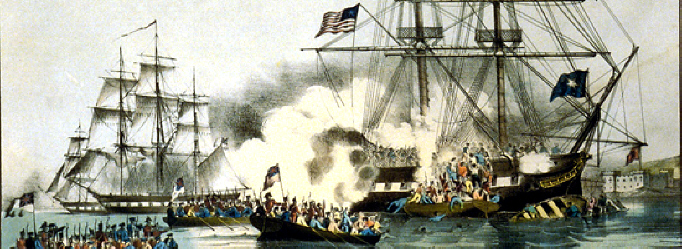

 named after the
Secretary of War, was built in 1812 in a very busy shipyard on New York's East River
by the brothers Adam and Noah Brown. The shipyard was at the end of Houston Street and the
money was put up by Renssalear Havens and other New York investors who would, after
clearance by a prize court, share the proceeds from their captures with the captain, crew,
American Marines and other stockholders.
named after the
Secretary of War, was built in 1812 in a very busy shipyard on New York's East River
by the brothers Adam and Noah Brown. The shipyard was at the end of Houston Street and the
money was put up by Renssalear Havens and other New York investors who would, after
clearance by a prize court, share the proceeds from their captures with the captain, crew,
American Marines and other stockholders.







 know of the USS Chesapeake incident in 1807 where
the Royal Navy forcibly took four sailors off a US Navy vessel and ended up hanging at
least one of them.
know of the USS Chesapeake incident in 1807 where
the Royal Navy forcibly took four sailors off a US Navy vessel and ended up hanging at
least one of them.









 Return to
the New York Military Affairs Symposium start page
Return to
the New York Military Affairs Symposium start page